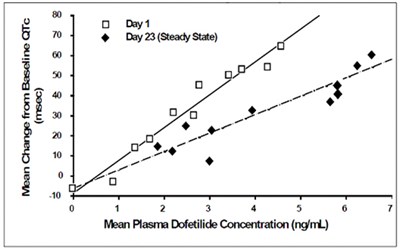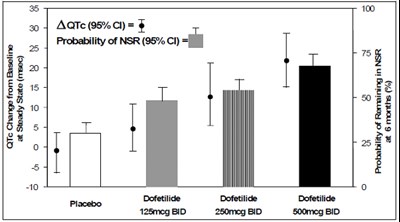Product Images Dofetilide
View Photos of Packaging, Labels & Appearance
Product Label Images
The following 9 images provide visual information about the product associated with Dofetilide NDC 75907-056 by Dr. Reddy's Labratories Inc., such as packaging, labeling, and the appearance of the drug itself. This resource could be helpful for medical professionals, pharmacists, and patients seeking to verify medication information and ensure they have the correct product.
PDP-0.125 mg 60ct - Dofetilide 07
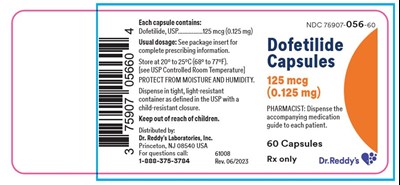
This text provides important information about Dofetilide capsules, each containing 125 meg (0.125 mg) of Dofetilide, USP. The usual dosage details can be found in the package insert along with complete prescribing information. It's advised to store these capsules at 20° to 25°C (68° to 77°F), in a controlled room temperature, protected from moisture and humidity. The text also mentions the need to dispense them in a tight, light-resistant container with a child-resistant closure. Distributed by Dr. Reddy's Laboratories, Inc., this medication comes in a package size of 60 capsules. Pharmacist instructions include dispensing the accompanying medication guide to each patient.*
PDP-0.25 mg 60ct - Dofetilide 08
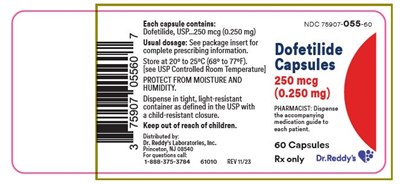
Each capsule contains Dofetiide, USP 250 mcg (0.250 mg). The usual dosage can be found in the package insert for complete prescribing information. It is recommended to store the capsules at 20° to 25°C (68° to 77°F) and protect them from moisture and humidity. Dispense in a tight, light-resistant container as defined in the USP with a child-resistant closure. Keep out of reach of children. These capsules are distributed by Dr. Reddy's Laboratories in Princeton, NJ. For any questions, contact TeBsT3ETEA 61010 REVTZS. This product is for prescription use only. The package contains 60 capsules.*
PDP-0.5 mg 60ct - Dofetilide 09
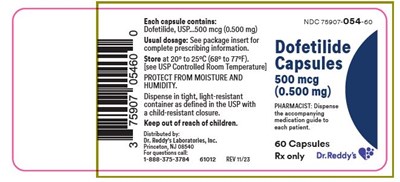
This text provides information about Dofetilide capsules, each containing 500 micrograms (0.500 mg) of the active ingredient. It includes details on dosage, storage conditions (20° to 25°C/68° to 77°F, protected from moisture and humidity), packaging instructions (light-resistant container with child-resistant closure), and a warning to keep it out of reach of children. The text also mentions the NDC (National Drug Code) number and advises referencing the package insert for complete prescribing information.*
Figure 3 - dofetilide 04
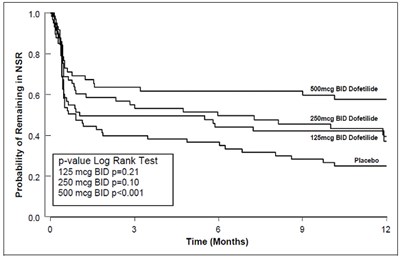
This text appears to be showing dosing information and results of a study with different drug dosages compared to a placebo over a period of time in months. The results include the p-values from a Log Rank Test for different dosage levels.*
Figure 4 - dofetilide 05
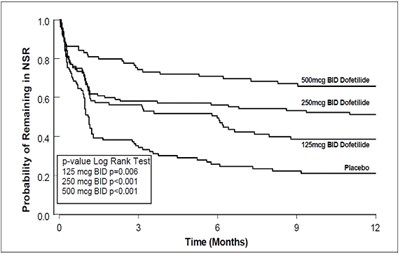
This text appears to contain numerical data and statistical information related to the survival time of subjects in different treatment groups and corresponding p-values from log-rank tests. The data includes dosages of a medication (125mg, 250mg, 500mg BID) and time points (6, 9, 12 months). It may be related to medical research or a clinical trial assessing the effectiveness of different doses of a medication on the survival rate of subjects over time.*
Figure - dofetilide 06
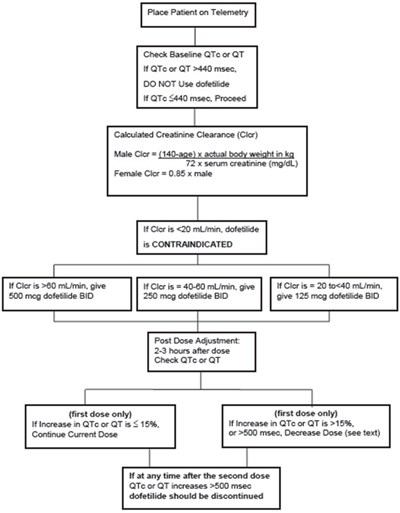
This text provides instructions for medical professionals on how to manage patients receiving dofetilide, a medication used to treat irregular heartbeats. It outlines the importance of monitoring the patient's QTc interval and creatinine clearance levels, and provides dosing recommendations based on these factors. Additionally, it details the protocol for dose adjustments and when to discontinue dofetilide based on QTc interval changes. This information is crucial for ensuring the safe and effective use of dofetilide in patients.*
* The product label images have been analyzed using a combination of traditional computing and machine learning techniques. It should be noted that the descriptions provided may not be entirely accurate as they are experimental in nature. Use the information in this page at your own discretion and risk.

